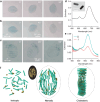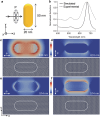Plasmonic Amyloid Tactoids
- PMID: 34658087
- PMCID: PMC11468577
- DOI: 10.1002/adma.202106155
Plasmonic Amyloid Tactoids
Abstract
Despite their link to neurodegenerative diseases, amyloids of natural and synthetic sources can also serve as building blocks for functional materials, while possessing intrinsic photonic properties. Here, it is demonstrated that orientationally ordered amyloid fibrils exhibit polarization-dependent fluorescence, and can mechanically align rod-shaped plasmonic nanoparticles codispersed with them. The coupling between the photonic fibrils in liquid crystalline phases and the plasmonic effect of the nanoparticles leads to selective activation of plasmonic extinctions as well as enhanced fluorescence from the hybrid material. These findings are consistent with numerical simulations of the near-field plasmonic enhancement around the nanoparticles. The study provides an approach to synthesize the intrinsic photonic and mechanical properties of amyloid into functional hybrid materials, and may help improve the detection of amyloid deposits based on their enhanced intrinsic luminescence.
Keywords: amyloid fibrils; fluorescence; gold nanorods; liquid crystals; plasmonics; self-assembly.
© 2021 The Authors. Advanced Materials published by Wiley-VCH GmbH.
Conflict of interest statement
The authors declare no conflict of interest.
Figures




References
-
- Dobson C. M., Nature 2003, 426, 884. - PubMed
-
- Sawaya M. R., Sambashivan S., Nelson R., Ivanova M. I., Sievers S. A., Apostol M. I., Thompson M. J., Balbirnie M., Wiltzius J. J., McFarlane H. T., Madsen A. O., Riekel C., Eisenberg D., Nature 2007, 447, 453. - PubMed
-
- Wasmer C., Lange A., Van Melckebeke H., Siemer A. B., Riek R., Meier B. H., Science 2008, 319, 1523. - PubMed
MeSH terms
Substances
Grants and funding
LinkOut - more resources
Full Text Sources

